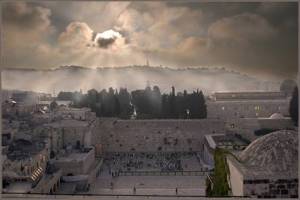
Editor’s note: This post originally appeared on Think Apologetics. Tabernacle of David considers this resource trustworthy and Biblically sound.
.

One objection that always comes up is that if Jesus is really the Messiah, how come there’s no peace in the world? So one of the traditional objections is that Jesus is not the Messiah since he did not fulfill the job description. One of the Jewish expectations is that the Messiah will enable the Jewish people to dwell securely in the land of Israel (Is.11:11-12; 43:5-6; Jer.23: 5-8; Mic.5:4-6), and usher in a period of worldwide peace.The Messiah is supposed to put an end to all oppression, suffering and disease (Is.2:1-22; 25:8; 65:25; Mic.4:1-4). Thus, if the Messiah has come, it seems that there is supposed to be societal and political transformation. Isa. 2:2–4 speaks of international harmony under the ruling Messiah will occur. While messianic salvation has been inaugurated in this present age, societal transformation of the nations has not happened yet. Passages like Isaiah 2, Micah 4:1-3 Isaiah 19:24–25, and Zechariah 14 predict nations will worship God.
So we are supposed to see the challenge: anti-missionaries can string together some texts in the Jewish Scriptures and then say “Case closed, Jesus is not the Messiah.” If you read the texts just mentioned, some of them don’t even mention a personal Messiah at all. Also, as I have said before, Israel’s faithfulness and the role of the Messiah go together. Thus, if Israel doesn’t fulfill their side of the covenant, there is a delay in blessings.
One text anti-missionaries try to use is Isaiah 11: 6-9:
“The wolf shall live with the lamb, the leopard shall lie down with the kid, the calf and the lion and the fatling together, and a little child shall lead them. The cow and the bear shall graze, their young shall lie down together; and the lion shall eat straw like the ox. The nursing child shall play over the hole of the asp, and the weaned child shall put its hand on the adder’s den. They will not hurt or destroy on all my holy mountain; for the land will be full of the knowledge of the LORD as the waters cover the sea (Isaiah 11:6-9).”
Now, it is obvious this text speaks of some sort of utopia conditions on earth. As Richard Bauckham says here in his online article:
“Occasionally this passage has been read as an allegory of peace between nations, while inattentive modern readers sometimes see it as a picture simply of peace between animals. In fact, it depicts peace between the human world, with its domestic animals (lamb, kid, calf, bullock, cow), and those wild animals (wolf, leopard, lion, bear, poisonous snakes) that were normally perceived as threats both to human livelihood and to human life. For the Israelite farmer, the unacceptable face of wild nature was these dangerous animals. What is depicted in the prophecy is the reconciliation of the human world with wild nature. Significantly, humans and domestic animals are all represented by their young, the most vulnerable. Each of the pairs of animals in verses 6-7 is carefully chosen, so that each predator is paired with a typical example of that predator’s prey. Especially from verse 7, it is clear that this peaceful condition is possible because the carnivorous animals have become, like the domestic animals, vegetarian. No doubt, this also includes humans. The pairing of the snakes and the children (v 8) differs from the other pairs in that the child is not the prey of the snake, but its poison is nonetheless dangerous to a child who ignorantly interferes with its hiding-place. This is a utopian (or, we might say, ecotopian) picture of the future kingdom of the Messiah that harks back to the primeval utopia that Genesis depicts as the beginning of human history.
Originally, all the creatures of the earth were vegetarian (Gen 1:29- Bauckham Page 3 30), and violence both among humans and between humans and animals came with the degeneration of life on earth that provoked the Flood (Gen 6:11-13). Isaiah’s description of the peaceable kingdom probably also alludes to the human responsibility for other living creatures that God gave humans at creation (Gen 1:26, 28). The first depiction of animals at peace (Isa 11:6) concludes: ‘a little child shall lead them.’ This is a reference to shepherding practice, in which the domestic animals willingly follow the shepherd who leads them to pasture. Even a small child can lead a flock of sheep or herd of goats, because no force or violence is required. In the ecotopia of Isaiah the little child will be able to lead also the wolf, the leopard and the lion. It is a picture of gentle and beneficial service to wild animals, which the animals now willingly receive. It is how we might imagine Adam and Eve related to the animals in the garden of Eden. This is not to say that the messianic kingdom is merely a return to the garden of Eden. It is more than that, but the original innocence of humans and animals does provide a model for the way this prophet envisages the future.”
Anti-missionaries like to say that in worshiping a deified Messiah/God man, Christians and Messianic Jews are committing idolatry. But the question is what kind of ordinary, anointed, Davidic King can usher in such a peaceable kingdom on earth and restore the earth back to Eden? The other problem is that perhaps there is societal peace unless there is peace between people. And the only way there can be peace between people is if mankind’s heart is changed. Thus, there needs to be atonement. I talk more about that here.
To see more about this objection, see Michael L Brown, General and Historical Objections

